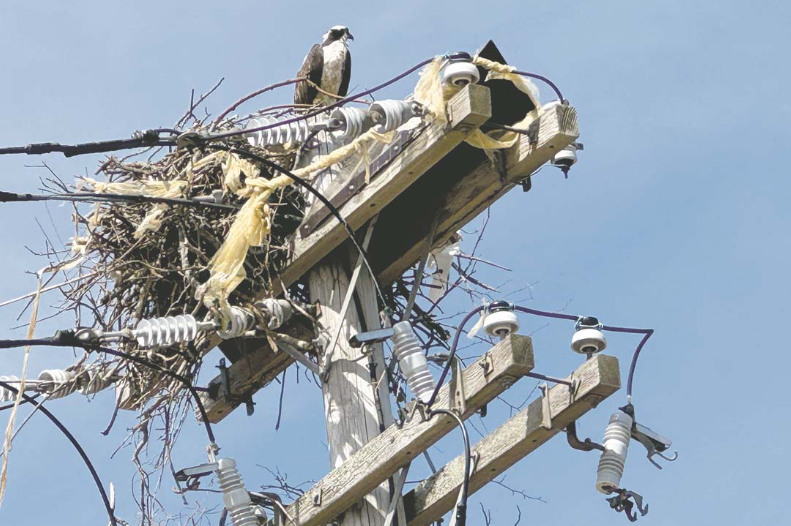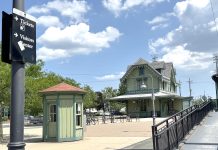
By Sunayana Prabhu
OCEANPORT – As spring bird migration sweeps through the Jersey Shore, some ospreys, known for their ability to return to the same nest site every year, will find their longtime nests gone as the entertainment giant Netflix advances its construction plans at the former Fort Monmouth.
Netflix, the official developer of the Fort Monmouth mega parcel, won borough approval last year and unanimous consent from the Monmouth County Commissioners last month to relocate the osprey nests on certain parcels it owns. However, permits to begin the eventual relocation of the nests are still pending. In September, the borough approved Netflix’s request to relocate the nests in compliance with a state directive that requires the developer to implement an “Avian Mitigation Plan.” The New Jersey Department of Environmental Protection (NJDEP) sets the state plan to protect and conserve wildlife.

New Nest Sites
According to Donna Phelps, Oceanport borough administrator, Netflix will relocate eight nests onto borough-owned property: one to Charles Park; two to Seawaneka Preserve; another two to Horseneck Preserve; and three at the Old Wharf Park adjacent to the Oceanport Avenue Bridge.
However, Netflix still needs to obtain a permit from NJDEP before moving the nests. “Without that permit, they’re not going anywhere,” said Phelps, who became familiar with the process four years ago during the construction of Oceanport Borough Hall, which had to be planned around nesting activity.
“There were nests out here when we were redoing the buildings, which are now borough hall, and we had to schedule our construction around April 1 to Aug. 30 when you really can’t be doing any building.”
According to a guidebook on the placement and relocation of osprey nests by the New Jersey Division of Fish and Wildlife (NJDFW), the nesting ospreys’ annual return to breeding sites ranges from January to May. Upon their arrival, osprey pairs begin to repair old nests or build new ones, often in trees or on man-made structures such as utility poles near or over water.
April to August is the most active nesting season, with nests containing eggs and dependent offspring. Inactive nests are identified as ones without any eggs or dependent young. The guidebook clearly states that the nests, whether active or inactive, “cannot be entered or disturbed without first obtaining a permit” from the state and federal wildlife agencies, with a host of other conditions that applicants must comply with.
Since ospreys feed mostly on fish, the undisturbed former military base, which abuts the Oceanport shoreline, has been an osprey nesting haven for years. But the area is now steadily transforming.
Netflix is “hoping to close on the property by the end of this year and start demoing buildings next year,” said Phelps. Full construction could potentially start in 2028. Several new businesses in the area have been attracted to the former fort property by the film studio. Additionally, Monmouth County officials recently approved a resolution to begin replacement of the aging Oceanport Avenue Bridge (E-13).

The bridge spans Oceanport Creek near Old Wharf Park, where Netflix is going to relocate three osprey nests. In a resolution passed March 13, county officials consented to Netflix’s relocation of the nests. Officials confirmed the relocation “will not have any effect on the replacement of the Oceanport Avenue Bridge.”
The county has been repairing and maintaining the bridge, which is “over 50 years old and reaching the end of its serviceable life,” officials said, due to deterioration from salt corrosion, the county said. The design phase for the bridge is expected to begin within the next two years, potentially coinciding with the Netflix construction.
Nest Removal Pushback
While Netflix’s plans comply with state and local environmental directives, not everyone is at ease with the relocation of osprey nests. Ospreys are considered “high site fidelity” birds because they return to their nests year after year.
“It’s not cool that they have to relocate them,” said Megan Kelly, who works at an office near Parkers Creek and gets a front row seat to an active nest through her window.
Although the borough has designated areas to relocate the nests, Kelly said the birds may fall prey to other territorial birds. “It doesn’t help with their safety again. Now they have to assess the other wildlife around and what might impact them. Are we moving them into someone else’s territory?”
She noted that other raptors, like eagles and hawks, are territorial, and she “can’t even imagine if there’s a turf war, so to speak.”
Thomas Tuorto, a nature photography enthusiast who has been capturing wildlife around the Two River area lamented how it seems the ospreys are “losing more and more” nesting area. He questioned why Netflix can’t “put up some nests for them.” At Oceanport Creek recently, Tuorto was aiming for the perfect shot. He called ospreys “fun” but “challenging” to capture on camera. He said they are “great hunters” that “very rarely… come up empty-handed.”
And Netflix isn’t the only corporation facing ire. Anthony Domalewski, the building maintenance manager at Trinity Hall, the all-girls school in Tinton Falls, contacted The Two River Times after Jersey Central Power & Light (JCP&L) removed a mature osprey nest from the school property around April 1. He said the nest had been home to a pair of ospreys and their young for several years.
“They took the nest away. Those birds had the nest there for years,” Domalewski said.
“We used to watch it, because I worked for the school, and they used to land there, then they just went. The poor things were lost, flying around looking for it (nest),” he said.
JCP&L, which has a broader avian protection initiative along the shoreline, coordinates nest relocation efforts with the NJDEP and the U.S. Department of Agriculture.
Christopher Hoenig, a JCP&L spokesperson, said, “We follow a very strict protocol to ensure that we do not disturb active nests.” Hoenig added that along the Jersey Shore, the company has safely relocated approximately 20 osprey nests since 2016 and is currently monitoring 72 known nesting locations, including one inactive nest at Fort Monmouth.
Ospreys nest on almost any tall structure near water where they can find fish and protection from ground predators such as raccoons. Ospreys nest on old duck blinds, channel markers, utility poles, docks and now more frequently on communication towers, docks, boat lifts, light poles, billboards and even chimneys along the Jersey Shore.
In January, the state removed ospreys from its endangered species list and changed the species status from threatened to stable.
The article originally appeared in the April 24 – 30, 2025 print edition of The Two River Times.














